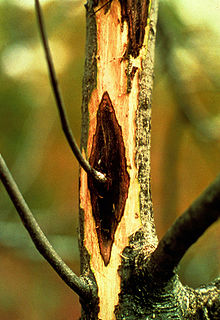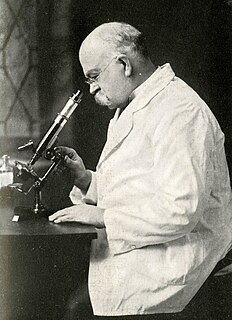
Canker generally refers to many different plant diseases of such broadly similar symptoms as the appearance of small areas of dead tissue, which grow slowly, often over years. Some are of only minor consequence, but others are ultimately lethal and therefore of major economic importance in agriculture and horticulture. Their causes include such a wide range of organisms as fungi, bacteria, mycoplasmas and viruses. The majority of canker-causing organisms are bound to a unique host species or genus, but a few will attack other plants. Weather and animals can spread canker, thereby endangering areas that have only slight amount of canker.
Totiviridae is a family of viruses. Giardia lamblia, leishmania, trichomonas vaginalis, and fungi serve as natural hosts. There are currently 28 species in this family, divided among 5 genera.
Nuper Rosarum Flores, is a motet composed by Guillaume Dufay for the 25 March 1436 consecration of the Florence cathedral, on the occasion of the completion of the dome built under the instructions of Filippo Brunelleschi. Technically, the dome itself was not finished until five months later, at which time a separate consecration was celebrated by Benozzo Federighi, the bishop of Fiesole, substituting for the newly appointed archbishop of Florence, Cardinal Vitelleschi.
Leptosphaeria coniothyrium is a plant pathogen. It can be found across the world.
Elsinoe rosarum, Anthracnose, is a fungal plant pathogen. It is a condition found on roses, causing leaves to have irregular dark margins and spots. The disease usually appears during wet weather.
Coniothyrium celtidis-australis is a species of fungus in the family Leptosphaeriaceae.
Coniothyrium wernsdorffiae is a plant pathogen that causes brand canker on rose.
Coniothyrium henriquesii is a plant pathogen.

Tetrops is a small genus of longhorn beetles found in Eurasia. One species, Tetrops praeustus, has recently been introduced in Eastern North America.

Eduard August von Regel, Russian: Эдуард Август Фон Регель; was a German horticulturalist and botanist. He ended his career serving as the Director of the Russian Imperial Botanical Garden of St. Petersburg. As a result of naturalists and explorers sending back biological collections, Regel was able to describe and name many previously unknown species from frontiers around the world.

Charles E. Fairman was an American physician who published in the field of mycology. He was for many years the health officer of Yates, New York, and on the staff of the Medina Memorial Hospital. A charter member of the Mycological Society of America, Fairman published several papers relating to fungi including the pyrenomycetes, the Lophiostomataceae, and the fungi imperfecti.

Platycheirus rosarum is a species of hoverfly found in the Palearctic. Like its close relative Platycheirus granditarsus, it can be found in marshy meadows and ditches; indeed, the two species can often be found together. The flight time is between May and October, though it peaks in abundance in June and July.

Pyrophaena is a subgenus of the hoverfly genus Platycheirus distinctive enough to sometimes treated as a separate genus in its own right. Indeed a recent study of the phylogeny of the subfamily Syrphinae found it to be closer to other certain other genera – Rohdendorfia, Syrphocheilosia and Spazigaster. Since only a few species were sampled the true systematic structure must await a more thorough survey of Platycheirus and related genera.
Coniothyrium is a genus of fungi in the family Phaeosphaeriaceae. The genus was circumscribed by Czech mycologist August Carl Joseph Corda in 1840.
Megachile rosarum is a species of bee in the family Megachilidae. It was described by Theodore Dru Alison Cockerell in 1931.
Victorivirus is a genus of viruses, in the family Totiviridae. Filamentous fungi serve as natural hosts. There are currently 14 species in this genus including the type species Helminthosporium victoriae virus 190S.
Tiarosporella urbis-rosarum is an endophytic fungus that might be a latent pathogen. It was found on Acacia karroo, a common tree in southern Africa.
Tetrops rosarum is a species of beetle in the family Cerambycidae. It was described by Tsherepanov in 1975. It is known from Russia and possibly Mongolia.
Allen Beville Ramsay was an English academic and Latin poet. He was Master of Magdalene College, Cambridge and Vice-Chancellor of the University of Cambridge.





